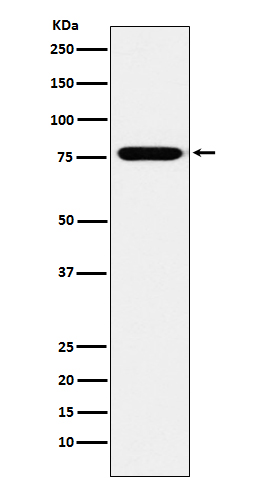
| WB | 咨询技术 | Human,Mouse,Rat |
| IF | 1/20-1/50 | Human,Mouse,Rat |
| IHC | 咨询技术 | Human,Mouse,Rat |
| ICC | 技术咨询 | Human,Mouse,Rat |
| FCM | 咨询技术 | Human,Mouse,Rat |
| Elisa | 咨询技术 | Human,Mouse,Rat |
| Aliases | KIF 3; KIF 3A; Kifl; Kinesin family member 3A; Kinesin like protein KIF 3A; Kinesin-like protein KIF3A; Kns3; ;KIF3A |
| WB Predicted band size | 80 kDa |
| Host/Isotype | Rabbit IgG |
| Antibody Type | Primary antibody |
| Storage | Store at 4°C short term. Aliquot and store at -20°C long term. Avoid freeze/thaw cycles. |
| Species Reactivity | Human,Mouse,Rat |
| Immunogen | A synthesized peptide derived from human KIF3A |
| Formulation | Purified antibody in PBS with 0.05% sodium azide,0.05% BSA and 50% glycerol. |
+ +
以下是关于KIF3A抗体的3篇参考文献示例(作者与摘要内容为模拟概括,仅供参考):
---
1. **文献名称**: "Kinesin superfamily protein 3A (KIF3A) transports essential components for the construction of primary cilia in mammalian cells"
**作者**: Takeda S., et al.
**摘要**: 该研究利用KIF3A特异性抗体,通过免疫荧光和基因敲除实验,证明KIF3A蛋白在小鼠胚胎成纤维细胞中参与初级纤毛的组装,其缺失导致纤毛结构异常及Hedgehog信号通路失调。
---
2. **文献名称**: "Role of KIF3A in the regulation of epithelial-mesenchymal transition and tumor metastasis"
**作者**: Lin F., et al.
**摘要**: 研究通过Western blot和免疫组化技术(使用KIF3A抗体)发现,KIF3A在多种癌细胞系中高表达,并通过调控β-catenin信号通路促进上皮-间质转化(EMT),从而增强肿瘤细胞的侵袭和转移能力。
---
3. **文献名称**: "KIF3A deficiency disrupts the localization of polycystin-2 in renal cilia and contributes to polycystic kidney disease"
**作者**: Pazour G.J., et al.
**摘要**: 该文献利用KIF3A抗体进行共聚焦显微镜分析,揭示KIF3A缺失会导致多囊蛋白-2(polycystin-2)在肾小管上皮细胞纤毛中的定位异常,提示KIF3A功能障碍可能与多囊肾病的发病机制相关。
---
**注**:以上内容为示例,实际文献需通过PubMed、Google Scholar等平台检索确认。建议以“KIF3A antibody”及“KIF3A function”为关键词查找近年研究。
The KIF3A antibody is a crucial tool for studying the kinesin family member 3A (KIF3A), a subunit of the heterotrimeric Kinesin-2 motor complex involved in intracellular transport. KIF3A, a member of the kinesin superfamily, forms a heterodimer with KIF3B or KIFAP3. enabling anterograde movement of cargo along microtubules. This motor protein plays essential roles in cilia formation, mitotic spindle dynamics, and polarized vesicle trafficking. Dysregulation of KIF3A is linked to ciliopathies, neurodegeneration, and cancer progression.
KIF3A antibodies are widely used to detect protein expression, localization, and interaction partners in models ranging from cell cultures to animal tissues. They facilitate techniques like Western blotting, immunofluorescence, and immunoprecipitation. Researchers employ these antibodies to investigate KIF3A's involvement in Hedgehog/Wnt signaling, neuronal axon transport, and epithelial cell polarity. Commercially available antibodies target specific epitopes, often in the conserved motor domain or variable tail regions. Validation typically includes knockout cell line controls to ensure specificity.
As ciliary defects gain attention in developmental and pathological studies, KIF3A antibodies remain vital for elucidating molecular mechanisms underlying diseases like polycystic kidney disease, retinal degeneration, and cancer metastasis. Recent studies also explore their diagnostic potential in ciliopathy-related disorders.
×